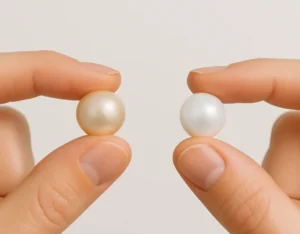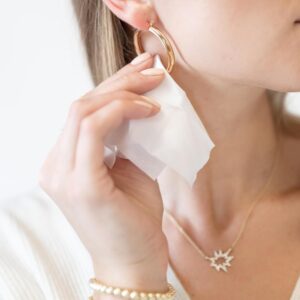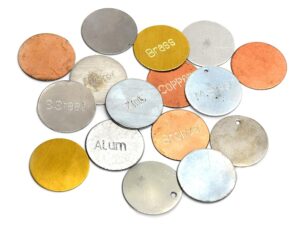Wondering how to tell if pearls are real or fake? You’re not alone.
Last week, my friend Sarah called me in excitement. She’d found a stunning pearl necklace at an estate sale for just $20. “But how do I know if these pearls are real?” she asked. Sound familiar?
Whether you’ve inherited grandmother’s pearls, scored a deal at a thrift store, or you’re shopping for that special piece, knowing how to identify real pearls can save you from costly mistakes and help you treasure genuine finds.
The good news? You don’t need expensive equipment or a gemology degree to test if pearls are real. I’ll walk you through 11 reliable methods that you can try right at home, plus when it’s time to call in the experts.
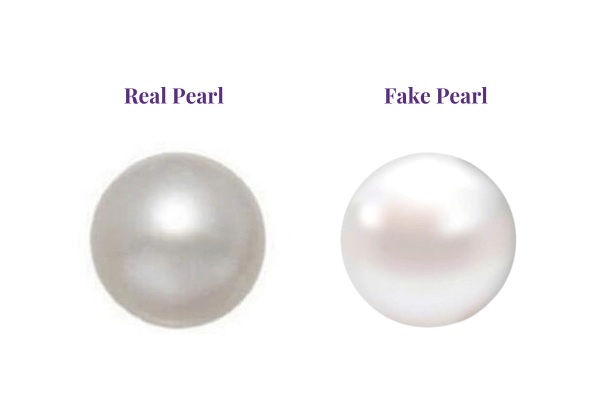
Table of Contents
Quick Reference: Real vs Fake Pearl Signs
Here’s your at-a-glance guide for how to spot real pearls:
| Sign | Real Pearls | Fake Pearls |
|---|---|---|
| Tooth Test | Feels slightly gritty when rubbed on teeth | Feels smooth, slippery, or plastic-like |
| Shape | Slightly irregular, natural variations | Too round, symmetrical, factory-perfect |
| Temperature | Cool to the touch initially | Matches room or body temperature instantly |
| Luster / Shine | Deep, soft inner glow (nacre shine) | Bright, glossy, or glassy artificial shine |
| Weight | Heavier and dense | Light (plastic) or unusually heavy (glass) |
| Drill Hole Appearance | Clean holes with visible nacre layers | Rough, chipped holes; glue or flaking coating visible |
| Surface Texture | Slight bumps or texture from natural nacre | Perfectly smooth, no surface variation |
| UV Light Reaction | Subtle bluish-green glow (or no reaction) | No glow or harsh artificial reflection |
| Rub Test | Slightly sandy feeling; may produce nacre powder | Feels smooth; no powder; often plasticky |
| Sound Test | Soft, dull “thud” when tapped together | Hollow or high-pitched “click” or “clink” |
| Wet Wipe Trick | No color comes off; remains unchanged | Coating may come off; reveals different material/color |
How to Tell If Pearls Are Real: 11 Simple Tests
There’s no need for fancy lab tools—these simple tests can help you figure out whether your pearls are real or fake, all from the comfort of home. Let’s start with the most famous one: the Tooth Test.
Before we start:
Don’t just depend on one test. Try a few different ones to be more sure if your pearls are real or fake.
Test #1: The Famous Tooth Test
This is probably the most well-known method to check if pearls are real, and for good reason—it works!
How to do it: Gently rub the pearl against your front teeth.
- Real pearls will feel gritty or sandy because of their natural nacre (the substance that makes pearls beautiful and valuable).
- Fake pearls made from plastic or glass will feel completely smooth.
Pro tip: Always clean the pearl with a soft cloth first. You don’t want to test dirty jewelry on your teeth!
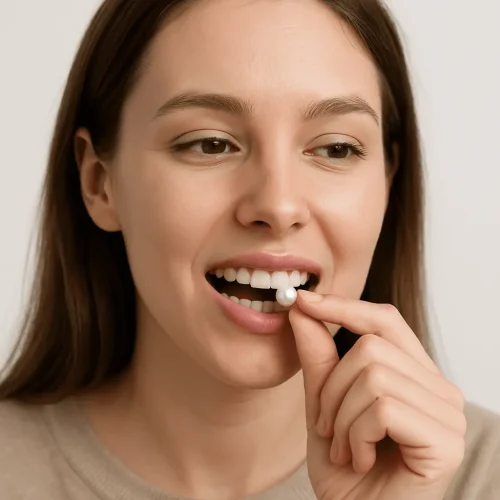
Test #2: The Weight Test
Are real pearls heavy? Yes — real pearls usually feel heavier than fake ones!
They have a dense, solid feel, even though they’re small. When you hold one, it should feel a bit weighty for its size.
Here’s how to test it:
- Hold a real pearl and a fake pearl (like plastic) in each hand.
- Compare how heavy they feel.
- Real pearls should feel heavier and more solid.
But be careful: Some fake pearls made of glass can also feel heavy. That’s why the weight test is helpful, but not enough on its own.
Tip: Combine the weight test with other checks — like the tooth test or looking closely at the surface — for the most accurate results.
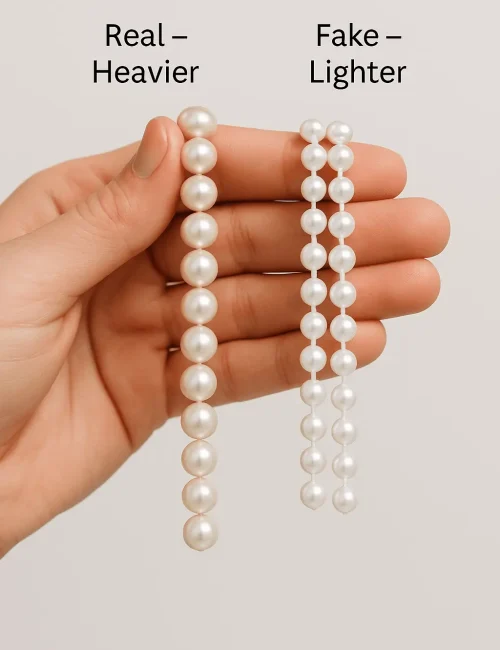
Test #3: Look for Natural Marks
Real pearls often have small spots, lines, or dents on their surface. These are natural marks and show that the pearl is real.
How to do it: Hold the pearl under good light and look closely. You might see:
- Tiny bumps or dots
- Faint lines or wrinkles
- Slight uneven color or shine
These small imperfections mean the pearl is natural or cultured.
Fake pearls, on the other hand, often look too perfect. Their surface is usually smooth, clean, and shiny with no marks at all—because they’re made by machines.
Remember: A real pearl’s beauty is in its little flaws!
Test #4: The Shape Test - Perfect Isn't Natural
Nature doesn’t usually make perfect circles—and the same goes for pearls. So What do real pearls look like? They often have subtle imperfections:
- Slight asymmetry
- Minor surface irregularities
- Natural variations in size (if it’s a strand)
Even the best real pearls usually show these subtle signs. So if you’re looking at a necklace where every pearl looks exactly the same—same size, shape, and surface—that’s a red flag.
In fact, pearls that are too perfect are often fake. A little natural variety is a good clue that your pearls might be genuine.
Test #5: The Luster Test - Glow vs Shine
Luster is one of the most telling signs of a real pearl. It’s not just about shine—it’s about depth, glow, and inner reflection.
Real Pearls:
- Have a soft, almost creamy glow that seems to come from within.
- Reflect light gently, with depth and richness.
- In natural light, they appear glowing, not flashy.
Fake Pearls:
- Often have a glassy, mirror-like shine.
- May look too shiny under artificial lighting.
- No sense of “depth” in the reflection.
How to Do the Luster Test: Place the pearl under natural and indoor light. Tilt it slowly to see the shine. Compare with a fake pearl to spot the difference in luster.
Testing tip: Look at the pearls under different lighting—natural daylight, indoor lighting, and lamplight. Real pearls will maintain their beautiful glow in all conditions.
Test #6: The Temperature Test
Temperature is a surprisingly easy clue to spot a real pearl from a fake.
Real Pearls:
- Feel cool to the touch initially—even in a warm room.
- Take a few seconds to warm up in your hand.
- This is due to their natural composition of layers of nacre.
Fake Pearls (Plastic or Glass):
- Often feel room temperature right away.
- Warm up almost instantly on contact.
- Glass fakes may feel cool too—so combine with other tests.
Try this: Place the pearl on your palm and count to ten. A real pearl should still feel cool, while a fake one will already match your hand’s warmth.
Test #7: The Rub and Sound Tests
This is actually two tests in one:
The Rub Test: Gently rub two pearls together.
- Real pearls will feel slightly sandy and may leave a tiny bit of nacre powder (which won’t damage them).
- Fake pearls feel smooth, like plastic or glass, and don’t leave any powder.
The Sound Test: Tap pearls together lightly:
- Real Pearls: Make a soft, dull “thud” when tapped together. Sound is subtle and cushioned.
- Plastic fakes: Make a light, hollow “click”.
- Glass fakes: Produce a sharp “clink”, more like marbles.
Be gentle with both tests! You’re not trying to damage the pearls, just listen and feel for these subtle differences.
Test #8: Examine the Drill Holes
Real pearls hide their secrets in the tiniest details—especially at the drill hole. A close look can reveal their true identity. Get a magnifying glass or use your phone’s camera to zoom in on the drill holes. What to Look:
Real Pearls:
- Clean, sharp edges around the hole.
- You may see concentric nacre layers (like tree rings).
- No signs of glue or bubbling.
Fake Pearls (Plastic or Glass with Coating):
- Chipped or flaking coating around the hole.
- Sometimes show glue residue or uneven drilling.
- The base material (white plastic or glass) may be exposed.
Test #9: The UV Light Test
Want a cool science trick to spot a real pearl? Use ultraviolet (UV) or blacklight—it reveals what the eye can’t see..
How to Do the UV Test: To use a UV light to check your pearls, turn off other lights, hold a UV penlight or blacklight about 2–3 inches from the pearls. Observe the glow—compare side by side if possible.
Under UV light:
- Real pearls may show a subtle bluish-green glow. The glow is subtle but steady—especially in natural or cultured pearls. Some real pearls show no reaction (this is normal).
- Fake Pearls may reflect harsh white or purple light, or show no glow at all. Plastic or glass fakes often look overly shiny or simply dull.
Test #10: The Wet Wipe Trick
Need a quick test while shopping or thrifting? This budget-friendly hack can help you spot fakes without any tools—just a baby wipe or damp cloth!
How to Do: Gently wipe one pearl with a fragrance-free baby wipe or a lightly damp cloth, then check the cloth and pearl for any color transfer or surface changes.
Real pearls won’t be affected by gentle cleaning.
Fake pearls with coating may:
- May shed paint, coating, or color.
- You might see a white film or residue on the wipe.
- Cheap fakes can even start to flake.
Test #11: The Taste Test (Use Sparingly)
Though not the most glamorous or recommended method, some seasoned collectors and jewelers use the taste test as a last resort—especially when other tools aren’t available.
- Real Pearls: May have a slightly salty or mineral-like taste, thanks to their marine origin.
(This is more noticeable with natural or untreated pearls.) - Fake Pearls: Tend to be tasteless or may even taste like plastic, paint, or chemicals.
I recommend extreme caution with this test:
- Only use on clean, modern pearls
- Never try this on vintage or dirty jewelry
- It’s not very reliable compared to other methods
Test #12: Professional Verification
Sometimes, DIY tests aren’t enough—especially when you’re dealing with high-value, vintage, or resale pearls. That’s when it’s time to bring in the pros.
When to Seek Professional Help:
- You’re buying or selling luxury pearl jewelry
- The piece is vintage or antique
- You need official documentation (appraisals, certifications)
- You’re unsure after home testing
Professional jewelers use:
- X-ray imaging to see internal structure
- Microscopic examination of nacre layers
- Specialized testing equipment
Many jewelry stores offer free basic authenticity checks. It’s worth asking!
Types of Pearls You Might Encounter
Not all pearls are the same, and knowing the types of pearls can help you spot real value and interpret authenticity tests more accurately.
There are three main categories:
- Natural Pearls: Formed without human intervention. Extremely rare and expensive. Almost always antique or vintage.
- Cultured Pearls: Grown on pearl farms with human assistance. Have real nacre layers and include most pearls on the market today (Akoya, Freshwater, Tahitian, South Sea).
- Imitation Pearls(Fake): Made from plastic, glass, or shell, then coated to mimic a pearl’s shine. No real nacre and can fail most authenticity tests.
Within cultured varieties:
- Akoya pearls, known for their perfect round shape and mirror-like luster, are saltwater pearls from Japan.
- South Sea pearls are among the largest and most luxurious, prized for their creamy glow.
- Tahitian pearls, often called black pearls, offer rare dark hues with green or purple overtones.
- You might also come across Baroque pearls, which have irregular shapes, or
- Keshi pearls, formed without a bead nucleus—pure nacre!
- Some fakes, like shell pearls, are made from crushed mother of pearl coated over a glass bead.
Understanding these types is essential—especially when shopping for a pearl engagement ring or earrings—to ensure you’re getting genuine quality.
Quick Tip: If your pearl passes many tests but still seems “too perfect,” it’s likely cultured—not fake! Cultured pearls are authentic and make up over 95% of real pearls sold today.
Frequently Asked Question's
Real pearls can chip if dropped or knocked hard, but they won’t peel like coating on fake pearls.
Real pearls sink.
They’re made of dense nacre, which makes them heavier than water. Most fake pearls (especially plastic ones) float or feel very light.
High-quality fakes are often made from glass with multiple coating layers. These can be tricky to identify with just one test.
Most fake pearls do not glow, or they glow with a bright white or violet reflection.
Real pearls may have a soft blue, green, or yellow glow under UV light, but this test is not 100% reliable on its own.
Too much water can damage pearls.
Real pearls are porous and can absorb water, which might weaken the silk thread and dull their luster. Occasional contact is okay, but avoid soaking or wearing them in the shower or swimming pool.
Gently expose the pearl to a lighter for a few seconds (only if you’re sure it’s not glued).
- Real pearls won’t be damaged.
- Fake pearls may melt, smell like plastic, or discolor.
Use this test carefully—it can ruin the jewelry if not done right.
Some can, but many will be damaged.
Plastic or coated fake pearls may lose their shine, peel, or weaken if soaked in water. Always dry them quickly if they do get wet.
Yes, over time, real pearls can turn yellow if not stored properly.
Exposure to heat, light, or air for long periods can age the nacre. Store them in a soft cloth and away from direct sunlight.
Yes, real pearls are delicate.
They rank about 2.5–4.5 on the Mohs hardness scale, so they can scratch if rubbed against metal or hard surfaces. Always store them separately.
Yes—quality pearl necklaces often have knots between each pearl.
This prevents them from rubbing against each other and stops them from all falling off if the string breaks.
Fake or cheap pearl strands often don’t have knots.
Final Words
Pearls can be special—whether they’re a gift, a memory, or a lucky find. Knowing how to check if they’re real helps you understand what you really have.
Don’t rely on just one method. The more tests you try, the clearer the picture becomes. And if you’re ever in doubt, a trusted jeweler can always offer expert insight.
Have you tried any of these tests on your own pearls? I’d love to hear about your discoveries in the comments below!

